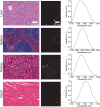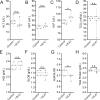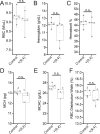Long-term in vivo biocompatibility of single-walled carbon nanotubes
- PMID: 32374764
- PMCID: PMC7202660
- DOI: 10.1371/journal.pone.0226791
Long-term in vivo biocompatibility of single-walled carbon nanotubes
Abstract
Over the past two decades, measurements of carbon nanotube toxicity and biodistribution have yielded a wide range of results. Properties such as nanotube type (single-walled vs. multi-walled), purity, length, aggregation state, and functionalization, as well as route of administration, greatly affect both the biocompatibility and biodistribution of carbon nanotubes. These differences suggest that generalizable conclusions may be elusive and that studies must be material- and application-specific. Here, we assess the short- and long-term biodistribution and biocompatibility of a single-chirality DNA-encapsulated single-walled carbon nanotube complex upon intravenous administration that was previously shown to function as an in-vivo reporter of endolysosomal lipid accumulation. Regarding biodistribution and fate, we found bulk specificity to the liver and >90% signal attenuation by 14 days in mice. Using near-infrared hyperspectral microscopy to measure single nanotubes, we found low-level, long-term persistence in organs such as the heart, liver, lung, kidney, and spleen. Measurements of histology, animal weight, complete blood count; biomarkers of organ function all suggest short- and long-term biocompatibility. This work suggests that carbon nanotubes can be used as preclinical research tools in-vivo without affecting acute or long-term health.
Conflict of interest statement
D.A.H. is named on a patent filed by MSKCC related to this work (“Composition and method for monitoring lipid”, US patent #10,401,295, issued September 3, 2019). D.A.H. is a cofounder and officer with equity interest of Goldilocks Therapeutics Inc., LipidSense Inc., and Nirova Biosense Inc., as well as a member of the scientific advisory boards of Concarlo Holdings LLC and Nanorobotics Inc. M.A.P. is a cofounder in Repair Ltd. R.E.S. is a member of the scientific advisory board of Miromatrix Inc. This does not alter our adherence to PLOS ONE policies on sharing data and materials.
Figures















Similar articles
-
A Carbon Nanotube Optical Reporter Maps Endolysosomal Lipid Flux.ACS Nano. 2017 Nov 28;11(11):10689-10703. doi: 10.1021/acsnano.7b04743. Epub 2017 Sep 12. ACS Nano. 2017. PMID: 28898055 Free PMC article.
-
A pilot toxicology study of single-walled carbon nanotubes in a small sample of mice.Nat Nanotechnol. 2008 Apr;3(4):216-21. doi: 10.1038/nnano.2008.68. Epub 2008 Mar 30. Nat Nanotechnol. 2008. PMID: 18654506
-
Filled and glycosylated carbon nanotubes for in vivo radioemitter localization and imaging.Nat Mater. 2010 Jun;9(6):485-90. doi: 10.1038/nmat2766. Epub 2010 May 16. Nat Mater. 2010. PMID: 20473287
-
Single-walled carbon nanotubes as near-infrared optical biosensors for life sciences and biomedicine.Biotechnol J. 2015 Mar;10(3):447-59. doi: 10.1002/biot.201400168. Epub 2015 Feb 13. Biotechnol J. 2015. PMID: 25676253 Review.
-
Two faces of carbon nanotube: toxicities and pharmaceutical applications.Crit Rev Ther Drug Carrier Syst. 2012;29(1):65-88. doi: 10.1615/critrevtherdrugcarriersyst.v29.i1.20. Crit Rev Ther Drug Carrier Syst. 2012. PMID: 22356722 Review.
Cited by
-
Membrane fusion and drug delivery with carbon nanotube porins.Proc Natl Acad Sci U S A. 2021 May 11;118(19):e2016974118. doi: 10.1073/pnas.2016974118. Proc Natl Acad Sci U S A. 2021. PMID: 33941689 Free PMC article.
-
Biokinetic Evaluation of Contrast Media Loaded Carbon Nanotubes Using a Radiographic Device.Toxics. 2021 Dec 2;9(12):331. doi: 10.3390/toxics9120331. Toxics. 2021. PMID: 34941765 Free PMC article.
-
Vertically Aligned Carbon Nanotubes as a Unique Material for Biomedical Applications.ACS Appl Mater Interfaces. 2022 Feb 9;14(5):6287-6306. doi: 10.1021/acsami.1c20423. Epub 2022 Jan 28. ACS Appl Mater Interfaces. 2022. PMID: 35090107 Free PMC article. Review.
-
Nanosensor-based monitoring of autophagy-associated lysosomal acidification in vivo.Nat Chem Biol. 2023 Dec;19(12):1448-1457. doi: 10.1038/s41589-023-01364-9. Epub 2023 Jun 15. Nat Chem Biol. 2023. PMID: 37322156 Free PMC article.
-
Strategies, Challenges, and Prospects of Nanoparticles in Gynecological Malignancies.ACS Omega. 2024 Aug 23;9(36):37459-37504. doi: 10.1021/acsomega.4c04573. eCollection 2024 Sep 10. ACS Omega. 2024. PMID: 39281920 Free PMC article. Review.
References
-
- Lehman JH, Terrones M, Mansfield E, Hurst KE, Meunier V. Evaluating the characteristics of multiwall carbon nanotubes. Carbon. 2011. July 1;49(8):2581–602.
Publication types
MeSH terms
Substances
Grants and funding
LinkOut - more resources
Full Text Sources
Other Literature Sources
Miscellaneous

